20 unacceptable errors during wiring
Before starting electrical work, read the following memo:
- Electrical wiring at home should begin with a carefully thought out wiring diagram. It is impossible to carry out electrical installation separately in each room, after which all lines in one node can be switched. This will entail the formation of many wire connections, as a result of which the reliability of the electrical network decreases markedly.
- The use of low-quality electrical products is the second blunder of the wiring in an apartment and a private house. Cheap Chinese products quickly fail, are unable to withstand rated loads and, moreover, often cause a fire in the house (or a short circuit).
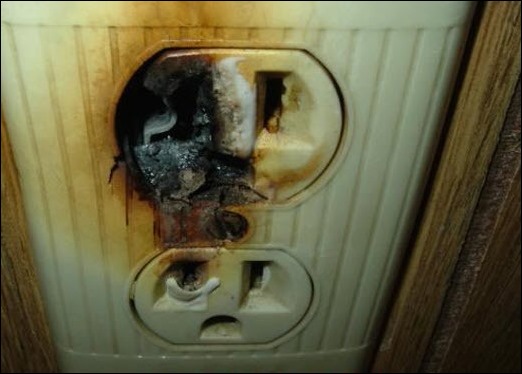
- Calculation of materials for electrical wiring is performed without stock. We have repeatedly said that with installation of wiring in the house you need to purchase 20% more materials, as well as choose a cable section with a small margin. This is necessary in order to play it safe and in the future to be sure that the home electrical system can withstand slightly increased loads. In addition, the supply of cable, sockets and switches will save you from the fact that at the very height of the wiring literally a meter of cable to the chandelier is not enough and you have to break down and go to the store, buy more materials. Remember that twisting is prohibited according to PUE and unreliable (you will either have to connect the missing piece, or lead a new, whole line from the junction box). Read the article how to make an estimate of electrical workso as not to make mistakes.
- Sockets are used to connect powerful electrical appliances. An ordinary 16-amp socket can withstand no more than 3.5 kW, so if you want to connect the hob 5 kW (or boiler, or heat gun), you need to lead a separate cable from the shield. Using more powerful outlets can also be a mistake, as the socket will withstand the load, but the cable is not in the wall (usually its cross section is 2.5 mm.kv.).
- Take seriously cable section calculation to enter the house, for outlets and for the lighting line. An undersized section can cause a fire to the electrical wiring as a result of current overload.
- In wooden houses, one of the errors in installing hidden electrical wiring is laying the cable line too close to the wooden wall cladding. As a result, when hammering a nail into a wall (for example, they wanted to hang a picture), an electric shock may occur if the cable insulation is damaged.Installation of hidden wiring in wooden houses is a very difficult task, which requires the implementation of a number of PUE standards, such as laying in pipes of fireproof material and others, we examined them in more detail in the article: https://my.electricianexp.com/en/montazh-elektroprovodki-v-derevyannom-dome.html. In general, when wiring in a wooden house, it is better to use open wiring in the cable channels.
- Connection in one junction box of power and low voltage wires. Some unfortunate electricians manage to mix power wires together with television, computer, telephone, etc. in one box. The price of such an error is the failure of household appliances, if somehow the contact of power wires with low-current ones occurs. In addition, due to tips appliances in the house may work worse.
- Using unsafe twists. Today for junction box wires best used WAGO terminalsthat allow you to safely connect multiple lines or vice versa, make wiring. The list of allowed connections is described in the chapter. 2.1. PUE Section 2.1.21, among them there is crimping with sleeves, the use of clamps, terminal blocks, soldering and welding. You can see why twisting is a dangerous wiring error in the photo below:
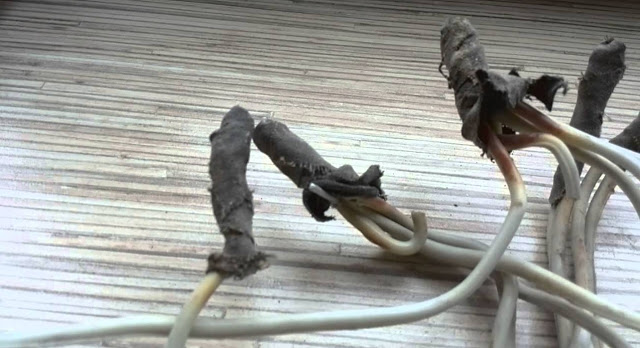
- The connection of copper and aluminum conductors is dangerous and cannot be performed (Chapter 2.1. PUE p. 2.1.71.). In general, you need to move away from the use of aluminum wires, because Aluminum itself is more fragile and, moreover, able to withstand lower loads compared to copper of the same cross section. Other than that in chapter 7.1. PUE Clause 7.1.34 states that in buildings, cables with copper conductors should be used. When aluminum comes into contact with copper, the compound overheats, which entails adverse effects. If it is not possible to bypass this dangerous contact, then be sure to use special car terminals or other terminal blocks to prevent the direct contact of aluminum and copper. Can also do bolted connectionby placing a steel washer between the cores of different materials.
- Work under tension. Of course, one of the most common mistakes of self-confident electricians and home craftsmen. Any electrical work must be carried out with the power off. Suddenly, the color coding does not match and before that, someone mistakenly led to the break of the light switch zero, not a phase. Even the simplest bulb replacement in this case can be fatal, not to mention wiring.
- Wall chipping only need to be done in horizontal and vertical direction. Driving obliquely from the power distribution box to the outlet is strictly forbidden along the shortest path. This error can cause electric shock when drilling a wall (you may stumble on a cable line). It is also important to note that in prefabricated houses, load-bearing walls cannot be completely drilled, according to Decree of the Government of Moscow of February 8, 2005 N 73-PP “On the Procedure for the Conversion of Premises in Residential Buildings in the City of Moscow”. As well as Government Decisions No. 508 (Clauses 11.3 and 11.11 of Appendix No. 1), which we described the link to which you see above.

- Junction boxes must be located on the ceiling (20 cm lower). In this case, you will protect the wiring from damage.
- No need to cut wires into pieces before wiring. Due to an error in the calculations, the light switch or chandelier may not be literally 20 cm long, as a result of which you will still have to cut the cable more authentically.
- Use special brands wires and cables when wiring on the street, in the bathroom or even in a wooden house. For example, underground you need to use an armored cable, and in the sauna heat-resistant.
- Observe the color coding of the conductors. Zero should be blue, the earth should be yellow-green, the remaining phase (usually white, brown or red).If in your case there is no color marking or you mistakenly mix colors, this can harm not only you, but also the electrician who will make the electrical installation during your absence.
- We have already touched on this moment a little higher - when installing lighting in a private house or apartment, a phase wire should always go to the breaker, and not zero! If you mistakenly do the opposite, even with the lights off, the lamp will be energized.
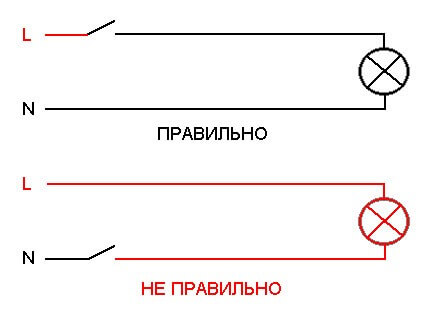
- Junction boxes must be protected from children, but at the same time accessible for inspection or repair (chapter 2.1. PUE, paragraph 2.1.23). It is not necessary to wedge them into a wall during electrical installation, as was done previously. If the light suddenly disappears in the apartment, you will have to tear apart expensive wallpapers to check all the connections.
- Before connecting the stranded wire to the screw clamp, the core must be crimped with a special sleeve (type tip NSHVI) or at least tinas shown below in the photo. Otherwise, such a connection will weaken after a while and begin to warm up, which will lead to a fire.
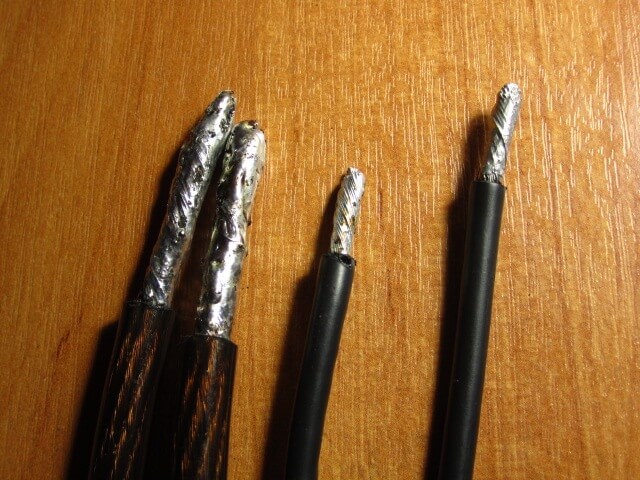
- Give due attention proper grounding of a private house. When mounting the internal ground loop, typical errors are often made: connect the ground wires between adjacent sockets with a cable, ground the gas pipes, etc. You can also read more about grounding in chapter 1.7. PUE.
- Be sure to pay attention to the correct connection of the RCD, as this device protects a person from electric shock. You can find out about errors when connecting an RCD in this video:
In addition, we recommend watching useful videos, which also discuss the main errors of electricians and even provide a clear example of an unsafe electrical network in an apartment:
So we examined the most dangerous wiring errors in a private house and apartment. Of course, in fact, electricians still allow many erroneous actions, but the points listed above are the most frequently encountered, so we paid special attention to them. If you have any questions, or just want to supplement our article, you can start communicating in the comments below the post, or even better - on our electricians forum.
It will be interesting to read:



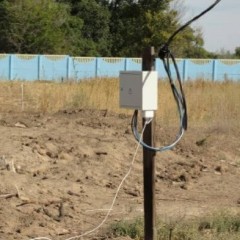
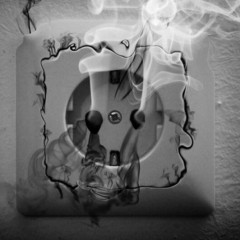
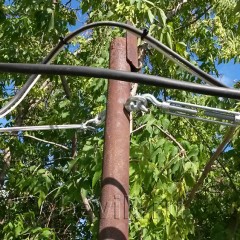

electrical standards 🙂
Can I clarify on point 19 about sockets? What does a train mean? And then how right? Thanks in advance!
Hello! When connecting the ground to several outlets (for example, in the unit), the ground wire must be inextricable. Those. Do not ground the sockets from one to the other with a jumper, but do a branch from the supply wire. To do this, use junction boxes, a bus, etc.
All branches, including grounding conductors, are described in GOSTs. The main requirements are solidity (uniformity of resistance) and independence. To comply with these rules, connecting buses are used that connect directly to the electrical installation, and consumers are branched off from them. It is very convenient to use WAGO terminals for connecting sockets. Personally, when I install several outlets in the unit, I use them. They have a monolithic connection between the contacts, which allows for independent branching of all three wires (phase, neutral and ground) to outlets.They fit very compactly in the installation box, which eliminates junction boxes when connecting several units, while the cable line is installed in the floor.
Pleased with the item about cheap Chinese electrical products, hinting that you need to use expensive Chinese electrical products? For everything that is done, everything in China.
Why, in all apartment buildings, according to the project, does the zero and not the phase break on the lamp?
6.6.28. In three- or two-wire single-phase lines of networks with a grounded neutral, single-pole switches can be used, which must be installed in the phase-wire circuit, or double-pole, with the possibility of disconnecting one zero working conductor without disconnecting the phase one.
This applies to all groups of circuit breakers (automatic and mechanical).
According to claim 6: as far as I know, hidden wiring is prohibited in wooden houses. So it is not recommended, but be sure to lay in cable channels!
Hidden wiring in wooden houses is not prohibited. But you just need to perform it in metal pipes. Moreover, the wall thickness of the pipe should be such that the pipe has localization ability, i.e. did not burn out during a short circuit. It is forbidden to use thin-walled metal pipes, a metal hose, a corrugation. And even more so, it is impossible to carry out such wiring with a cable or wire. You can put the wiring in the plaster or surround it on 4 sides with non-combustible materials, only the thickness of the plaster or other non-combustible material on each of the 4 sides should be at least 10 mm. At the joints, there should be metal or other non-combustible junction boxes through which, in addition, there would be the possibility of replacing a failed wiring.
Thank you very much for your work, but I still have a few details that I don’t understand:
> Remember that twisting is prohibited according to the PUE and unreliable (you will either have to connect the missing piece, or lead a new, whole line from the junction box). Read the article on how to make an estimate of electrical work in order to avoid mistakes.
>> Is it possible to simply solder and insulate the missing piece?
> We have already touched on this point a little higher - when installing lighting in a private house or apartment, a phase wire should always go to the breaker, and not zero! If you mistakenly do the opposite, even with the lights off, the lamp will be energized.
>> I can’t understand one thing: in order for the appliance to work, you need plus (phase) and minus (earth). If you connect only a phase or only earth, then the device simply will not work, in this case the bulb simply does not light up. So what's the difference? It’s clear that it’s more reasonable, but I would like to hear a scientific explanation.
>> Pay due attention to the proper grounding of your private home. When mounting the internal ground loop, typical errors are often made: connect the ground wires between adjacent sockets with a cable, ground the gas pipes, etc. You can also read more about grounding in chapter 1.7. PUE.
>> And why can not be connected by a cable? Suppose, initially, 2 squares are planned for an outlet, for example, let’s say, for four outlets there is a “common” wire of 8 squares, it is connected in a box with a bus and 4 outlets with grounding of 2 squares are connected to this bus. So why pull 4 wires of 2 squares, if you can ground everything with one thick wire?
1. I didn’t understand what you don’t understand ...
2. Yes, you can solder and insulate.
3. The circuit breaker must break the phase, because if it breaks zero, then when you change the lamp, you can be shocked even when the circuit breaker is turned off, and LED lamps can also be turned off.
4. Minus or zero - this is not the earth, is it to the previous one about the switch was, as I understand it?
5 and 6. The point is that the grounding conductor cannot be looped, it must be inextricable from the bus to the outlet, or from the box to each outlet.With a loop connection - when removing or malfunctioning one of the outlets - the rest will remain unprotected.